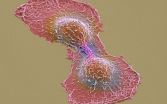Survival molecule helps cancer cells hide from the immune system
2014-10-07
(Press-News.org) COLUMBUS, Ohio – A molecule that helps cancer cells evade programmed self-destruction, an internal source of death, might also help malignant cells hide from the immune system, an external source of death.
A new study by researchers at The Ohio State University Comprehensive Cancer Center – Arthur G. James Cancer Hospital and Richard J. Solove Research Institute (OSUCCC – James) shows that a molecule called nuclear factor kappa B (NF-kB) helps cancer cells by inhibiting the immune system's ability to detect and destroy them. The molecule regulates genes that suppress immune surveillance mechanisms, including the production of cells that inhibit the immune response.
The research suggests that immune therapy for cancer might be more effective if combined with drugs that inhibit NF-kB. They also provide new details about how interactions between cancer cells and noncancer cells assist tumor growth.
The findings are published in the journal Cell Reports.
"We've long known that NF-kB promotes cancer development by subverting apoptosis, an internal safety mechanism that otherwise would cause cancer cells to self-destruct," says principal investigator Denis Guttridge, PhD, professor of molecular virology, immunology and medical genetics and of molecular and cellular biochemistry.
"This study shows that NF-kB might coordinate a network of immune-suppressor genes whose products enable tumor cells to evade adaptive immunity," he adds. "Therefore, inhibiting NF-kB will might make tumor cells more vulnerable to elimination by the immune system."
A 2009 study by the same researchers showed that NF-kB helps normal cells in DNA repair, which might prevent them from harming the body. However, it is hard to understand why such a molecule might act differently in cancer cells, where NF-kB is typically always found in an active state.
For this study, Guttridge, first author David J. Wang, who developed many of the study's concepts, and their colleagues monitored NF-kB activity during tumor development using mouse embryonic fibroblasts and two mouse models. Key technical findings include:
During early tumor development, macrophages – innate immune cells – migrate into the tumor;
NF-kB enables cancer cells to survive the pro-apoptotic influence of tumor necrosis factor that is released by tumor infiltrating macrophages;
NF-kB may also regulate a number of genes related to immune suppression, particularly TGF-beta, IL-10, GM-CSF, G-CSF and VEGF.
In cancer cells with active NF-kB, shutting down TGF-beta expression removed its immune suppressive influence and delayed tumor growth, evidence that TGF-beta is a gene regulated by NF-kB that contributes to tumor development.
"Overall, our findings demonstrate that NF-kB might play a pivotal role in enabling cells to evade surveillance by both innate and adaptive immune cells," Guttridge says.
INFORMATION:
Funding from the NIH/National Cancer Institute (grant CA140158) supported this research.
Other Ohio State researchers involved in this study were Nivedita M. Ratnam and John C. Byrd.
The Ohio State University Comprehensive Cancer Center – Arthur G. James Cancer Hospital and Richard J. Solove Research Institute strives to create a cancer-free world by integrating scientific research with excellence in education and patient-centered care, a strategy that leads to better methods of prevention, detection and treatment. Ohio State is one of only 41 National Cancer Institute (NCI)-designated Comprehensive Cancer Centers and one of only four centers funded by the NCI to conduct both phase I and phase II clinical trials. The NCI recently rated Ohio State's cancer program as "exceptional," the highest rating given by NCI survey teams. As the cancer program's 228-bed adult patient-care component, The James is a "Top Hospital" as named by the Leapfrog Group and one of the top cancer hospitals in the nation as ranked by U.S.News & World Report.
ELSE PRESS RELEASES FROM THIS DATE:
2014-10-07
DALLAS – Oct. 7, 2014 – Researchers at UT Southwestern Medical Center have found an "Achilles heel" in a metabolic pathway crucial to stopping the growth of lung cancer cells.
At the heart of this pathway lies PPARγ (peroxisome proliferation-activated receptor gamma), a protein that regulates glucose and lipid metabolism in normal cells. Researchers demonstrated that by activating PPARγ with antidiabetic drugs in lung cancer cells, they could stop these tumor cells from dividing.
"We found that activation of PPARγ causes a major metabolic ...
2014-10-07
State policies can influence the number of physicians licensed to prescribe buprenorphine, a drug that can treat addiction to heroin and other opioids in outpatient settings, according to a new RAND Corporation study.
Examining county-level numbers of physicians approved to prescribe buprenorphine, researchers found a significant link between the number of approved physicians and both specific state guidance regarding the use of buprenorphine and the distribution of clinical guidelines for buprenorphine treatment. The findings were published online by the Journal of ...
2014-10-07
Alexandria, Va., USA – Poor oral health and hygiene are increasingly recognized as major risk factors for pneumonia among the elderly. To identify modifiable oral health-related risk factors, lead researcher Toshimitsu Iinuma, Nihon University School of Dentistry, Japan, and a team of researchers prospectively investigated associations between a constellation of oral health behaviors and incidences of pneumonia in the community-living of elders 85 years of age or older. This study, titled "Denture Wearing During Sleep Doubles the Risk of Pneumonia in Very Elderly," ...
2014-10-07
ALLENDALE, Mich. — Even among contemporary U.S. distance runners, men are still much more likely than women to have a competitive orientation, according to researchers at Grand Valley State University in Allendale, Michigan. The findings were published in the online journal, Evolutionary Psychology at http://www.epjournal.net/articles/u-s-masters-track-participation-reveals-a-stable-sex-difference-in-competitiveness/
The new research, led by Robert Deaner, associate professor of psychology at Grand Valley State, shows that, on average, American men participate at ...
2014-10-07
Researchers at the University of California, San Diego School of Medicine have identified a microRNA molecule as a surprisingly crucial player in managing cell survival and growth. The findings, published in the October 7 issue of Cell Metabolism, underscore the emerging recognition that non-coding RNAs – small molecules that are not translated into working proteins – help regulate basic cellular processes and may be key to developing new drugs and therapies.
Specifically, principal investigator Albert R. La Spada, MD, PhD, professor of cellular and molecular ...
2014-10-07
From AGU's blogs: Detecting avalanches from sounds we can't hear http://blogs.agu.org/geospace/2014/10/07/detecting-avalanches-sounds-cant-hear/
Researchers have developed a new avalanche monitoring method that uses sound below the range of human hearing to detect and track these deadly and destructive snow slides. The technique can detect an avalanche from the moment it starts, picking up the unheard thump of a rupture in the snowpack that can precede the snow cascade. It can then track the avalanche's path second by second down the mountain.
In a new study published ...
2014-10-07
When kids say "the darnedest things," it's often in response to something they heard or saw. This sponge-like learning starts at birth, as infants begin to decipher the social world surrounding them long before they can speak.
Now researchers at the University of Washington have found that children as young as 15 months can detect anger when watching other people's social interactions and then use that emotional information to guide their own behavior.
The study, published in the October/November issue of the journal, Cognitive Development, is the first evidence that ...
2014-10-07
LAWRENCE — Scientists have been laboring to detect cancer and a host of other diseases in people using promising new biomarkers called "exosomes." Indeed, Popular Science magazine named exosome-based cancer diagnostics one of the 20 breakthroughs that will shape the world this year. Exosomes could lead to less invasive, earlier detection of cancer, and sharply boost patients' odds of survival.
"Exosomes are minuscule membrane vesicles — or sacs — released from most, if not all, cell types, including cancer cells," said Yong Zeng, assistant professor ...
2014-10-07
You're obese, at risk for diabetes and cardiovascular disease, and so motivated to improve your diet that you've enrolled in an intensive behavioral program. But if you need to travel more than a short distance to a store that offers a good selection of healthy food, your success may be limited.
A new study from UMass Medical School and the Massachusetts Department of Public Health finds that not having close access to healthy foods can deter even the most motivated dieters from improving their diet, suggesting that easy access to healthy food is as important as personal ...
2014-10-07
Imagine attempting to trace your genetic history using only information from your mother's side. That's what scientists studying the evolution of the red fox had been doing for decades.
Now, University of California, Davis, researchers have for the first time investigated ancestry across the red fox genome, including the Y chromosome, or paternal line. The data, compiled for over 1,000 individuals from all over the world, expose some surprises about the origins, journey and evolution of the red fox, the world's most widely distributed land carnivore.
"The genome and ...
LAST 30 PRESS RELEASES:
[Press-News.org] Survival molecule helps cancer cells hide from the immune system





